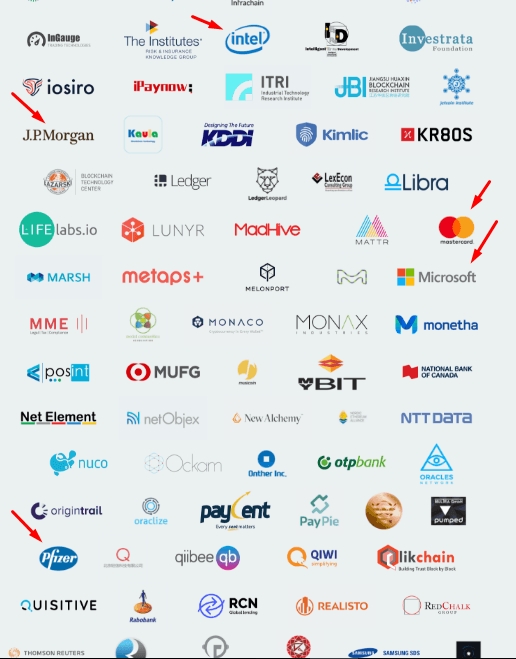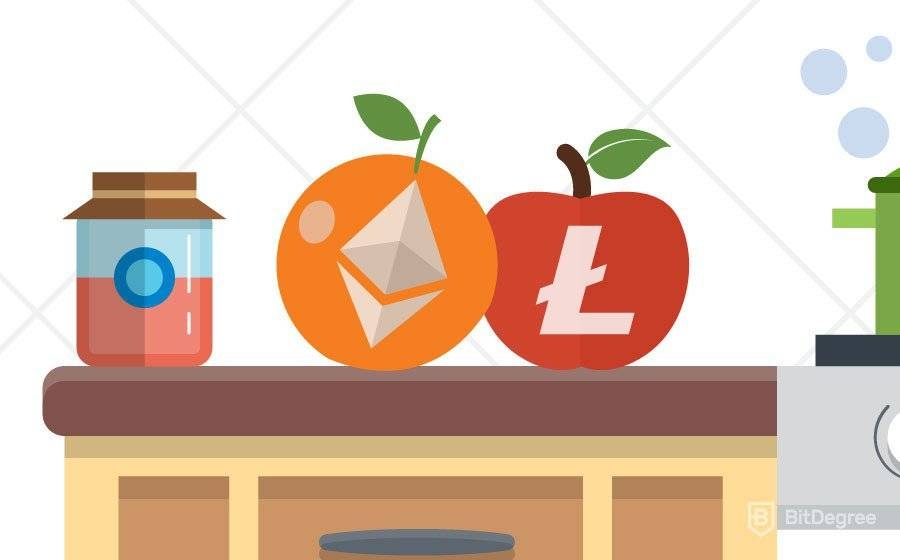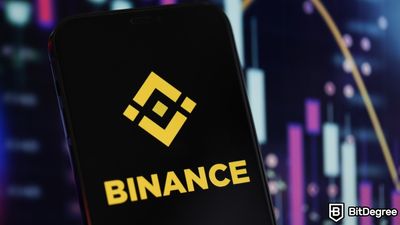Stop overpaying - start transferring money with Ogvio. Sign up, invite friends & grab Rewards now! 🎁
This guide has been prepared to explain the differences between Ethereum and Litecoin. On the Ethereum side, it will cover the following topics: what Ethereum is, how Ethereum uses smart contracts to create more use cases than other blockchain-based currencies, Ethereum’s history, and a little about the Enterprise Ethereum Alliance.
After the section about Ethereum, I’ll move on to Litecoin. Litecoin is a bit easier to understand, meaning there’s less to cover. We’ll look at what Litecoin is, Litecoin’s history, and the reason it was created in the first place!
Following each explanation, there will be a section comparing Litecoin vs Ethereum. This will include a look at the different technologies behind each cryptocurrency. I’ve included a Litecoin vs Ethereum comparison chart too.
Finally, there’s a section on using each technology for payments. This will look at Litecoin vs Ethereum from a currency point-of-view only. It will compare the transaction times and costs of each digital currency. This should help you decide on Litecoin vs Ethereum when trying to choose which currency to use to pay for goods or services online.
TIP: If you are already very familiar with both Litecoin and Ethereum and just want to see how they compare to one another, skip to Litecoin vs Ethereum: Comparing Technologies.
By the end of this guide, you should understand the following:
- The differences between Ethereum and Litecoin
- The advantages and disadvantages of each
- How they got started
- Why they were created
- A little about using both Litecoin and Ethereum
We’ll then round things off with a short conclusion about Litecoin vs Ethereum.
As usual, we have a lot to get through.
So, let’s not waste any more time and jump right into it!

Did you know?
Subscribe - We publish new crypto explainer videos every week!
Candlesticks, Trendlines & Patterns Easily Explained (Animated Examples)


Table of Contents
- 1. Litecoin vs Ethereum: What is Ethereum?
- 1.1. Smart Contracts
- 1.2. Ethereum’s Background
- 1.3. Enterprise Ethereum Alliance
- 2. Litecoin vs Ethereum: What is Litecoin?
- 2.1. History of Litecoin
- 3. Litecoin Vs. Ethereum: Comparing Technologies
- 3.1. Litecoin vs Ethereum: The Facts
- 4. Ethereum vs Litecoin: The Prices?
- 5. Ethereum vs Litecoin: For Payments?
- 6. Litecoin vs Ethereum: Conclusion
Litecoin vs Ethereum: What is Ethereum?
Ethereum is a public blockchain that allows developers to create decentralized applications (dApps) on it. Like the Bitcoin blockchain, Ethereum has its own native coin or currency. This is called Ether (ETH). Many people incorrectly use the term Ethereum to describe both the currency and the network itself.
Latest Deal Active Right Now:For now, the Ethereum network is secured using a PoW (Proof-of-Work) protocol. This is the same as Bitcoin. PoW requires advanced computers to solve complicated math problems.
These computers are known as miners. If you’re familiar with crypto, you’ve probably heard the term miners before!
The miners verify transactions of blocks in the Ethereum blockchain (by solving math problems) and are rewarded for their service in Ether. They also check that entries on the blockchain follow the network’s rules. This system is very secure, but it uses a lot of electricity because mining is very, very demanding.
Ether can be used like Bitcoin, as a tradable currency. It can also be used to pay for things. However, unlike Bitcoin, Ether can be used to power certain features within dApps. For example, when creating a token on the Ethereum blockchain or using a smart contract the developer or user must pay the network in Ether (ETH).
Smart Contracts
The Ethereum network also differs from Bitcoin because it’s possible to create smart contracts using it. You can think of smart contracts as programmable money. Smart contracts are programs that are built using computer code. They allow users to transfer value between one another without using a middleman. Smart contracts will automatically transfer the asset when the conditions of the contract are met.
A simple example of a smart contract is used when developers make initial coin offerings on the Ethereum blockchain. An Initial Coin Offering (an ICO) is a way of using smart contracts and cryptocurrency to raise money for a new idea.
The company behind the idea will create a whitepaper that explains their plan and they ask for anyone interested in the idea to buy a token that will eventually be used by the application.
Note: Some tokens have no use on the application created for the idea and instead are just used for financial gain etc., but some do. Those that do not have any use on the application are known as ‘security tokens’, whereas the latter is known as utility tokens. There is no fine line between them, though, as some utility tokens have attributes of a security token, too.
The tokens are locked into a smart contract that is created using the Ethereum network. The smart contract will state that a certain number of tokens will be paid out for every unit of Ether that is received.
When the Ether is received, the tokens are sent to the address of the contributor automatically. No third party is needed to say that the tokens will be sent out. It’s all done using computer code!
Smart contracts are designed to be impossible to change once they have been agreed upon by the parties using them. They can be used to remove the middlemen from many different types of transactions. One example is the sale of a house…
Typically, when the deeds to a property change hands, expensive legal departments are needed to make sure that the contract is followed. Using smart contracts, there is no need to involve lawyers in the process.
Of course, this saves all the people involved both time and money. After all, layers are not known for being cheap!
Ethereum’s Background
The idea of Ethereum dates back to 2013. A young cryptocurrency expert and coder called Vitalik Buterin thought that Bitcoin needed more functions than just a secure digital money system. He argued that adding a programming language to Bitcoin would let applications be built on it. The Bitcoin community largely disagreed. This led Buterin to create his own blockchain.
In early 2014, the Ethereum project was announced. Buterin was joined by Mihai Alisie, Anthony Di Iorio, and Charles Hoskinson. This early version of the Ethereum team began working on the idea throughout 2014 through a company called Ethereum Switzerland GmbH. They also created the non-profit organization – the Ethereum Foundation.
The project was launched in July 2015. The foundation had “pre-mined” 11.9 million ETH to sell to potential investors. This was one of the first examples of an ICO Those who wanted to invest would send BTC to the foundation and receive a set amount of the new Ether coins in return.
At this stage, each coin was worth less than $1. If any of the original contributors held onto them until today, they’d be very happy with their investment too!
Ethereum is a software platform that is constantly changing. The early versions of the software were buggy and unstable. The first version that was considered stable appeared in March 2016! It was known as “Homestead”.
Homestead was followed by the current version of the Ethereum software platform in October 2017. This is called Metropolis.
The final version will be known as “Serenity”. In Serenity, there will be a change from the Proof-of-Work (PoW) system that currently checks transactions to one called Proof of Stake (PoS).
Rather than using large amounts of computing power and electricity, in a Proof-of-Stake system, users who hold large amounts of Ether check transactions instead.
If they break the network’s rules in any way, by letting someone send the same ETH twice, for example, the user that is staking their currency will lose their Ether. This makes sure the rules are followed.
Enterprise Ethereum Alliance
During 2017, the excitement began to grow around Ethereum. This is because the Enterprise Ethereum Alliance (EEA) was announced. The EEA is made up of many different companies. Many of them are household names. These companies were included in the alliance because they were interested in looking at how the Ethereum software platform could benefit their industries.
Understandably, having the likes of Toyota, Samsung, Microsoft, JP Morgan, Intel, and Deloitte saying that were interested in the project increased demand for Ether token.
During 2017, it rose from a price of around $8 per ETH in early January to a high of over $800 in late December 2017. It then went on to reach around $1,400 per ETH in January 2018!
As you can see from the below pictures, there are some very impressive names on the Enterprise Ethereum website. They’re not all from the financial and technology sector either!

Litecoin vs Ethereum: What is Litecoin?
Litecoin is very different from Ethereum. It has much more in common with Bitcoin than Ethereum does.
Litecoin is a digital currency in its truest sense. Unlike with the Ethereum software platform, there is no second layer for application development on Litecoin. So, its sole purpose is to be used as a currency.
Like Bitcoin and Ethereum, Litecoin is a peer-to-peer and completely open source. This means that anyone can download the software code, join the network and mine Litecoin.
History of Litecoin
Next, in this Litecoin vs Ethereum guide, I’ll cover a brief history of Litecoin.
Litecoin was launched in October 2011 by former Google employee Charlie Lee. The similarities with Bitcoin are because it is actually a fork of Bitcoin.
A fork is what happens when the miners of a Proof-of-Work blockchain disagree on an update. When there is no agreement, the update becomes a fork. The miners that updated the software now mine the fork, the miners that didn’t update continue to mine the original. This means that the blockchain has now split.
This is how Litecoin was created — Charlie Lee issued a Bitcoin update, but not enough of the miners downloaded the update. So, the update/fork became Litecoin.
Lee had been involved in an earlier altcoin called Fairbrix. This was designed to be a fairer version of another early altcoin called Tenebrix. However, many in the community complained that the anonymous Tenebrix founders had mined millions of coins for themselves before the software was released!
Lee’s Fairbrix was designed to only allow CPUs (regular computers) to mine on the network. The idea was that this would create even more decentralization than Bitcoin because anyone who owns a computer has a CPU and can, therefore, become a cryptocurrency miner.
Fairbrix had some features that would make it into Lee’s next project, Litecoin. However, there were problems with the programming code. These issues destroyed the Fairbrix coin before it was even launched.
Lee was still convinced he could make a fairer and more usable version of Bitcoin though. He took most of the work he’d done on Fairbrix and copied various parts of the Bitcoin code to patch over the mistakes he’d made when programming the Fairbrix code.
From the beginning, Litecoin was designed to be a fairer, faster, and cheaper version of Bitcoin. Using a different proof-of-work system meant that it was easier to mine Litecoin using CPUs for longer than Bitcoin. However, it soon became obvious that more advanced systems could also mine the currency. Today, like Bitcoin, Litecoin is mostly mined on specialized computer systems called ASICs.
In May of 2017, Litecoin implemented a software upgrade known as Segregated Witness. The upgrade was created for Bitcoin but infighting in the BTC community meant that it couldn’t be agreed on as early as it was for Litecoin.
The idea behind Segregated Witness, or SegWit for short, was to split the data about transactions. Only the data that was necessary would be stored on the blockchain. This made it possible to fit more transactions into each block and increased the number of transactions that the network could complete every second.
The idea was that even faster transactions would make Litecoin more suitable for smaller payments than Bitcoin that had become expensive to transact with. SegWit would later be activated on the Bitcoin blockchain too.
The first ever Lightning Network transaction and atomic swap were also on Litecoin too. Lightning Network is a software upgrade that will allow small transactions to happen off the blockchain. Although less secure than on chain transactions, Lightning Network transactions will make blockchains suitable for small payments such as buying a cup of coffee.
Meanwhile, atomic swaps are a new way to swap one cryptocurrency for another that doesn’t rely on a centralized exchange. Atomic swaps are thought to reduce the need to use exchanges that are often hacked, causing users to lose their cryptocurrency.
These two upgrades will bring even more functionality to both Litecoin and eventually Bitcoin too.
Today, Lee sees Bitcoin and Litecoin as working together rather than against each other. Since the entire market cap of Litecoin is smaller than Bitcoin’s, there is less risk when trying out new software upgrades to Litecoin. In this way, Litecoin acts as something of a test network for its bigger, more established brother.
Litecoin Vs. Ethereum: Comparing Technologies
Litecoin and Ethereum are very different blockchain projects. As I’ve already stated, Litecoin is a payment system that is very much like Bitcoin but faster and cheaper.
Meanwhile, Ethereum is a decentralized computer system with its own programming language. This allows developers to create decentralized applications using smart contracts.
Both Litecoin and Ethereum have faster transaction times than Bitcoin. On the Litecoin network, new blocks are formed every 2.5 minutes. Ethereum has a much faster blockchain and new blocks are formed every 10 to 20 seconds.

Did you know?
Subscribe - We publish new crypto explainer videos every week!
What is a Crypto Mining Pool? Is it Worth it? (Beginner-Friendly)



- Secure and reliable
- Accepts fiat currencies
- Lots of trading options
- Reputable exchange
- Accepts fiat currencies
- Offers various trading options

- Huge trading variety
- Regulation-compliant around the globe
- Fair trading fees
- Beginner-friendly
- A wide array of features
- Vast number of different crypto coins & tokens

- Beginner-friendly
- Secure
- Decent trading and withdrawal fees
- Crypto.com Visa Card
- Automated tools & bots
- Ecosystem synergy with CRO
Litecoin vs Ethereum: The Facts
The following chart is accurate as of March 20, 2018. Many of the below values change over time.
| Ethereum | Litecoin | |
| Total Supply of Coins | Unclear | 84,000,000 |
| Current Available Supply | 98,310,400 | 55,714,900 |
| Average Transaction Cost | $0.21 | $0.21 |
| Average Block Time | 10-20 Seconds | 2.5 Minutes |
| Proof-of-Work Algorithm | Ethash | Scrypt |
| Primary Use | Creating dApps | Payment and test network for Bitcoin |
| Founder | Vitalik Buterin | Charlie Lee |
Ethereum vs Litecoin: The Prices?
You’ve probably noticed a difference between Ethereum and Litecoin’s prices. This is because the total amount of money invested in each is different. Not only that, but the number of units of each currency is also different. The prices are worked out by taking the total money in the market (or market capitalization) and dividing it by the number of units that are currently available. This will result in a different price per unit.
Although the market cap of Ethereum is currently more than five times the size of Litecoin’s, the price is less than five times that of ETH. This is because there are many more Ether coins available than Litecoins.
When looking at Coinmarketcap, or any other price comparison website, you will see the total money in the market is represented by the column “market cap”. I’ve highlighted Ethereum’s market cap in green and Litecoin’s in red below:

In the next picture, I’ve highlighted the current circulating supply. These figures will change over time as new coins are unlocked through mining.
Again, it’s green for Ethereum and red for Litecoin:

Ethereum vs Litecoin: For Payments?
Since it has a much faster block generation time, it seems like Ethereum is a faster means of payment than Litecoin. However, this isn’t always the case. Since Ethereum is a much more complicated system with many more transactions occurring per second, the network can get filled up more easily.
Take the example of CryptoKitties, a popular Ethereum-based trading game that appeared late in 2017. It was so popular that transactions of digital cats filled up all the space on the chain. As cute as they are, CryptoKitties wasn’t popular with people trying to make genuine payments or build dApps on the network!
Since the Litecoin blockchain only stores data about payments, users are much less likely to experience delays when making transactions. However, it will be slower than Ethereum if neither blockchain is being used heavily that day.
That said, it makes sense to use Litecoin for payments since Ethereum is being used to develop potentially world-changing applications. Keeping the network free for developers to experiment on is, therefore, a good idea.
Litecoin vs Ethereum: Conclusion
Well, that’s it for my Litecoin vs Ethereum guide!
Hopefully, you should now know a little bit more about two of the largest cryptocurrencies by market cap. You should understand the difference between Ethereum and Litecoin, know about the history of the two, and who created them both.
You should also know about the technical differences between the two cryptocurrencies. Finally, you should be able to make a choice between Litecoin or Ethereum when it comes to making payments.
If you’ve followed the whole guide, you should have concluded that there the two aren’t really in competition. Instead, they offer very different functions. For that reason, it’s better not to think of Litecoin vs Ethereum since they can both live side by side!
So, with your new-found knowledge, what do you think the future holds for Litecoin and Ethereum? Be sure to let me know!
The content published on this website is not aimed to give any kind of financial, investment, trading, or any other form of advice. BitDegree.org does not endorse or suggest you to buy, sell or hold any kind of cryptocurrency. Before making financial investment decisions, do consult your financial advisor.









